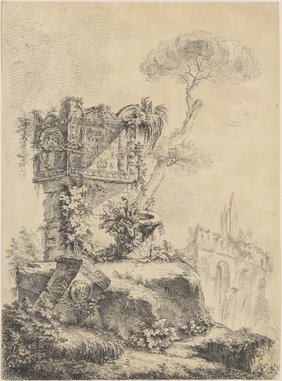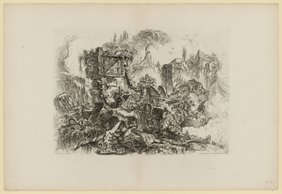The pen-and-ink drawing shows an antique Roman funerary monument with conspicuous relief decoration enthroned on a massive plinth on a hill. Its ruinous condition is accentuated by the rampant vegetation, an overturned altar in the foreground and a single already brittle basket capital from which acanthus is sprouting. A gnarled pine tree rises from the stone relics, and in the background on the right the substructures of a monumental complex are fading.
The sheet is closely related to an etching from the four-sheet series of the so-called "Grotteschi", which Giovanni Battista Piranesi (1707 –1778) created and published between 1747 and 1749. The etching "Tomba di Nerone" (Fig. 1) shows the same monuments. G. B. Piranesi combines them as a capriccio with other antiquities and fantastic elements such as a dolphin lying over a wall and numerous writhing snakes, creating a threatening ominous mood. In its form and setting, the tomb is reminiscent of the tomb of Publius Vibius Marianus in Rome, but differs in the details of the distinctive reliefs. Located on the Via Cassia and initially misinterpreted as the tomb of Nero (Tomba di Nerone), it was and still is known – and found – under this name. G. B. Piranesi adopts the high corner acroteria of the monument of P. Vibius Marianus, its relief-decorated inscription panel and the positioning on the hill, but chooses forms for the decoration of his representation, such as the fascia bundles or the clasped hands with caduceus, which are not to be found on the original but have indeed been handed down from ancient reliefs. Moreover, his inscription actually refers to Nero. For the "Grotesque", Piranesi, as it were, invents a fictitious funerary monument of Nero from antique fragments and makes use of the association and common equation with the real tomb of P. Vibius Marianus.
The pen-and-ink drawing, which faithfully copies G. B. Piranesi's invention, was acquired by Albrecht Haupt at the auction of Heinrich Lempertz senior's collection of hand drawings (J. M. Heberle, 17 October 1905, lot no. 450). The sheet bears the collector's stamp H. Lempertz on the verso (Lugt 1337). Haupt mounted, as he did more often, two small cuttings from the auction catalogue on the lower margin of the backing board: they contain the artist's details "Giamb. Piranesi (1707 –1778)" and the description of the lot "‘Landschaft‘ mit Ruinen, verfallenen Monumenten etc. – H 340, Br 250 mm. Vollendete ausgeführte Federzeichnung". Haupt changed the attribution in pencil and replaced "Giamb." with "Francesco". With the attribution to the son Francesco Piranesi (1758 –1810) it was clear to Haupt that the drawing must have been made after his father's etching. By dispensing with the obviously grotesque pictorial elements, the draughtsman presents the monument in the manner of a Roman veduta: the focus, however, is on a fictitious tomb, which – unlike in the decidedly eclectic model of the "Grottesche" – becomes a curiosity.
Birte Rubach


